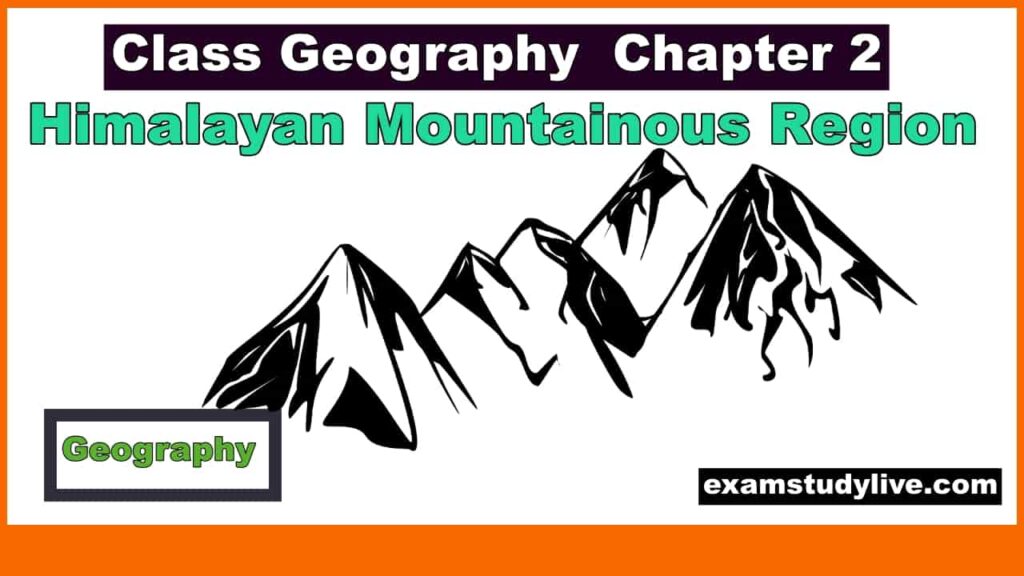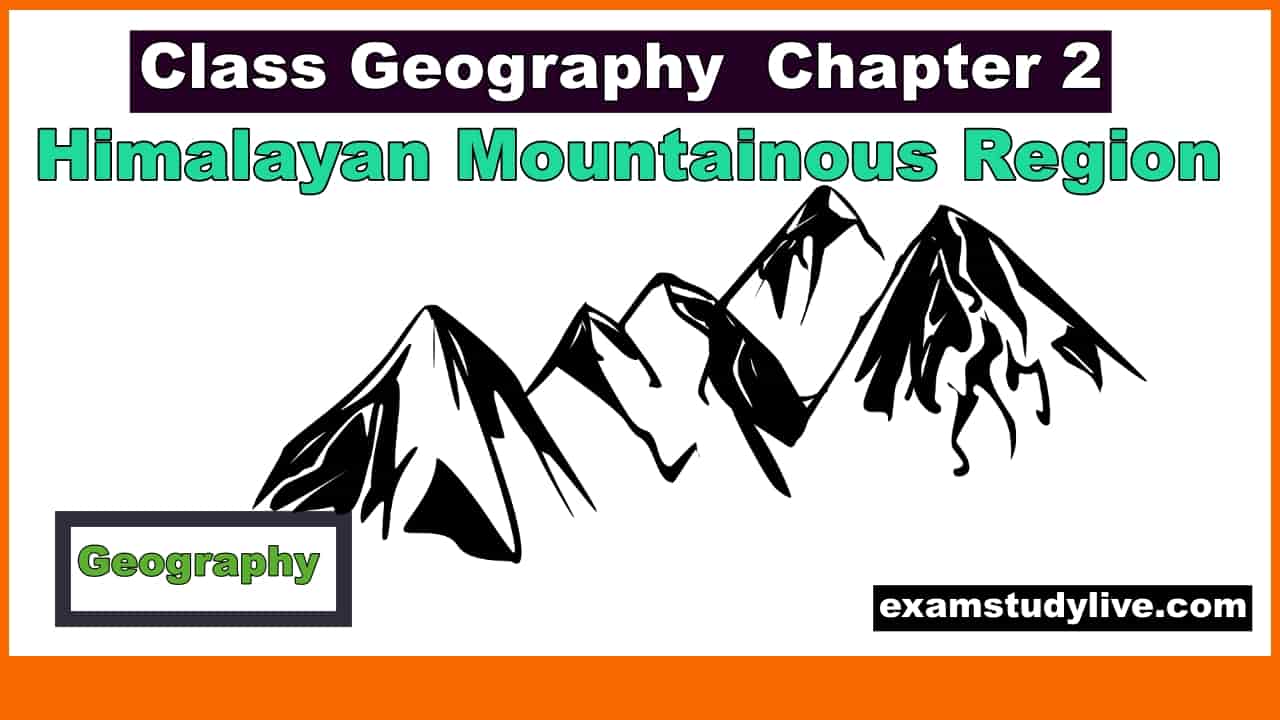After a brief introduction about the country, we will get detailed information about its facility facilities. India’s relief is nowhere to be found. in this article, you will get Class 9 Geography Chapter 2 Notes.
On the north side, the Himalayas have large plains formed by mountains and rivers. To its south, is a steep rock formed by old rocks.
Due to its age, this triangular plate plays a very important role in the creation of the Indian landscape.

All other geographical features of the country were present after this plate was formed. That is why this peninsula is also known as the center of Indian geography.
Coastal plains along the coasts on all three sides of this plate. Apart from these, many islands are found in the sea areas.
According to the Census Commissioner of India, the physical division of the total area of the country is as follows:
Mountains – 10.7 percent
Hills – 18.6 percent
Plateau- 27.7 percent
Plains – 43.0 per cent
The surface of India is divided into five parts these are as follows
(I) Himalayan Mountainous Region
(II) The Great Northern Plain
(III) Peninsular Plateau Region
(IV) Coastal Plains
(V) The Indian Islands
Also read this: Class 12 Geography Chapter 1 Notes
(Class 9 Geography Chapter 2 Notes)
Himalayan Mountainous Region
A) Extent:
The West Himalayan Himalayas form the northern boundary of India. This large hill station stretches 2400 km from Arunachal Pradesh in the east to Jammu and Kashmir in the west.
The mountain width varies from 240 km to 320 km. The total area of the area is 5 lakh km and the average elevation is about 5100 meters or 1 of 17,000 feet.
(B) Origin:
These mountains started to rise 400 million years ago.
In the present part of the Himalayas, there is the Tethys Sea and in the sea, the bed is sedimented by rivers, then south by Kondwana (Deccan Plateau), Tibetan Plateau in the north.
Due to the internal forces of the world, the two plates started moving towards each other. As a result, folds form in their sediment, and their height increases.
These mountains are still rising. Due to the great elevation, these young mountains have nothing but the snow-covered Himalayas. These mountains are also known as ‘Himvan’ or Himadari of Himachal Pradesh.
(C) Shape:
Towards our country the shape of the Himalayas is like a convex curve, whose middle portion is curved till the Nepal border.
Many times it looks like a bow.
which has threads on its two ends in the form of mountains, reaching on one side from Safed Koh, Suleman, and Kuithar to the Arabian Sea in the north-western part.
And to the other side in the north-eastern part, going up to the Bay of Bengal, along Indo-Burma hills from Arakanyoma to Tenasserim mountain ranges.
(D) Slope:
The slope of these mountain ranges in the south towards India is very steep, whereas it has a gentle slope towards China in the north. That is why it is difficult to cross these from the south.
They supply water to northern India, with which the great planes of India receive a national blessing.
Classification
The Himalayan complex can be subdivided on the basis of height into the following five sub-divisions from north to the south:
(1) The Trans Himalayas
(II) The Great Himalayas
(III) The Lesser Himalayas
(IV) The Outer Himalayas
(V) Off – Shoots.
(Class 9 Geography Chapter 2 Notes)
#1 The Trans Himalayas
These magnificent boundaries of the Himalayas meet the Pamir knot of northwestern India.
They are also known as the ‘Tibet Himalayas’, as most of them fell in Tibet. Their total length is 970 km.
Their width is 40 km at the end and 222 km at the center. Their average elevation is 6100 meters.
Zaskar, Ladakh, Karakoram, and Kailash are important mountain ranges. This mountain range is famous for its high, twisted peaks and large glaciers.
Mount Godwin Austin (K2) (8611 m) is the tallest in the region and the second highest peak in the world.
Hidden Peak- 8068 metres
Brand Peak – 8047 metres
Gaysherboom – 8035 metres
RackaPashi – 7788 metres), and
Harmosh – 7397 metres etc are its other important peaks.
The famous glaciers of this range are Hispar and Batugh – 57 Kilometres and Beacko and Baltoro- 60 kilometres.
(Class 9 Geography Chapter 2 Notes)
#2 The Great Himalayas
(a) Name:
This part of the Himalayan region is also known as Himadri, or Inner Himalayas or the central Himalayas.
(b) Extent:
This is the longest and tallest subdivision mountain range in the country, starting from the deep valley of the Indus River in the west to the Dihang Valley of the Brahmaputra River in the northeast.
These mountains are made of crystalline rocks of archaeological times, such as granite, gneisses, and scholars of the Old Geological Age.
(c) Size:
The range is 2400 km long and the average elevation is 6000 meters or 20000 feet. Its range of breadth is 100 to 190 km.
d) peaks:
Some of the highest peaks in the world can be found in this category. Mountains. Everest (8848 m) is the highest peak in the world.
Other significant high peaks are:
Kanchanjanga – 8598 m.
Makalu-8481 m.
Dhaulagiri -8172 m.
Manaslu-8156 m.
Choe-Olju-8153 m.
Nanga Parbat-8126 m.
Annapurna-8078 m.
Nanda Devi -7871 m.,
Nanoha Barwa -7756 m and
Harmosh -7397 m.
(e) Passes:
It is very difficult and dangerous to cross this mountain range. But many routes to reach Tibet are still found to go above 4500 meters.
Burzil and Zojila in Kashmir, Chang La, Lanak La, Bata Khepcha La, Khurnak La in Ladakh, Korika and Shipki La in Himachal Pradesh, Niti, Thag La, Lipu Lekh, are the main examples of such passes.
Tatkala Kot in Uttar Pradesh and Nathula in Sikkim, Jhelum law. The trade on the road between India and Tibet is only two routes from the aforesaid route.
(Class 9 Geography Chapter 2 Notes)
(f) Valleys:
The mountains of the Greater Himalayas are also known as snowy ranges due to snowfall for most of the year. This is where long-lived rivers are formed.
Large valleys formed as sediments deposited by these rivers in lakes at an altitude of 1500 meters. The Kathmandu Valley and the Kashmir Valley are famous for this view.
#3 The Lesser Himalayas
This third division of Himalayas is also known as Himachal or Central Himalayas. They started about 30 million years ago.
It has an average elevation of 3500 to 5000 meters and an average width of 60 to 80 km. The ‘Southern Spurs’ of the Great Himalayas join this region.
At higher elevations, snowfalls in winter and favourable weather dominates in summer.
(a) Ranges:
Dhauladhar in Himachal, Pir Panjal and Nag Tibba in Kashmir, Mahabharat in Nepal, Thimphu in Bhutan, Mussorie in Uttar Pradesh are the major mountain ranges of this mountain.
(b) Valleys:
The region consists of long and recreational valleys like the Kangra Valley, Kashmir Valley, Kullu Valley, Mandakini Valley and Bhagirathi Valley.
(c) Health resorts and tourist centres:
Many beautiful tourist and health centers like Shimla, Srinagar, Nainital, Mussoorie, Darjeeling and Chakrata and located in this region.
#4 The Outer Himalayas
This mountain range of the Himalayas is also called as Shiwalik, Sub-Himalayas and Southern Himalayas.
These mountain ranges parallel the south-east to the west in the lower Himalayas. Their average height is 900 to 1200 meters and their width ranges from 15 to 50 kilometers.
This region was created in the third period. Long and deep sedimentary rocks are found in this area.
They are formed by mud soils, sandstone and rivers coming from the Himalayas according to the plateaus. Later in this third period, the sedimentary rocks were transformed into mountains folded by the internal forces of the earth.
These mountains created lakes that blocked the flow of flowing rivers, which were filled with sediment and called ‘doons’.
#5 The Off-Shoots
The Himalaya takes its eastern and western edges north-south. These hills are situated on the shore which is called eastern and western off-shoots respectively.
(a) The Eastern Off-Soots:
These off-shoots are also called Purvanchal. After forming the border between eastern India and Myanmar (Burma), these boundaries are divided into two parts, starting from the Dihang Valley in Prampur in Arunachal Pradesh:
(i) Formed by Ganga-Brahmaputra, – it reached the plains of Bangladesh, including the Tripura hills, Garo, Dapha Bum, Khasi, Patkai Bum, and Jaintia.
(ii) The second off-shoot – starting from Patkai Bum to Naga hills, Brail, and Lusai reaches the delta of Irawadi.
The main peaks in the eastern shoots of the Himalayas. Saramati-3926 meters, Dapha Bum-4578 meters, and Jpau.
(b) The Western Off-Shoots:
The Himalayan ranges from Pamir Knot to the north-west are divided into two subdivisions. The first off-shoot that flows in the southeastern direction.
The second off-shoot connects the Caucasus mountains and the Hindu Kush of Afghanistan.
(Class 9 Geography Chapter 2 Notes)

